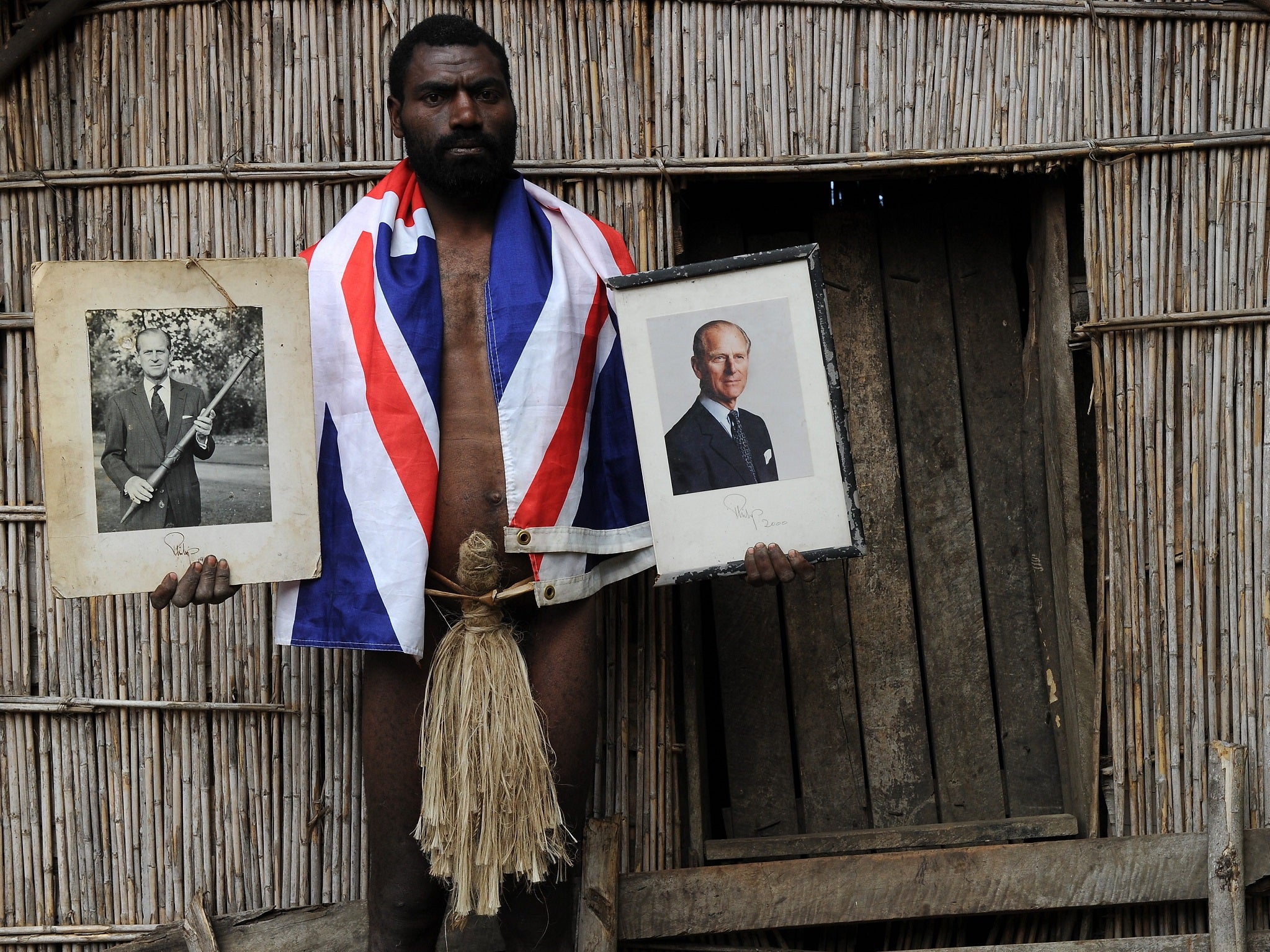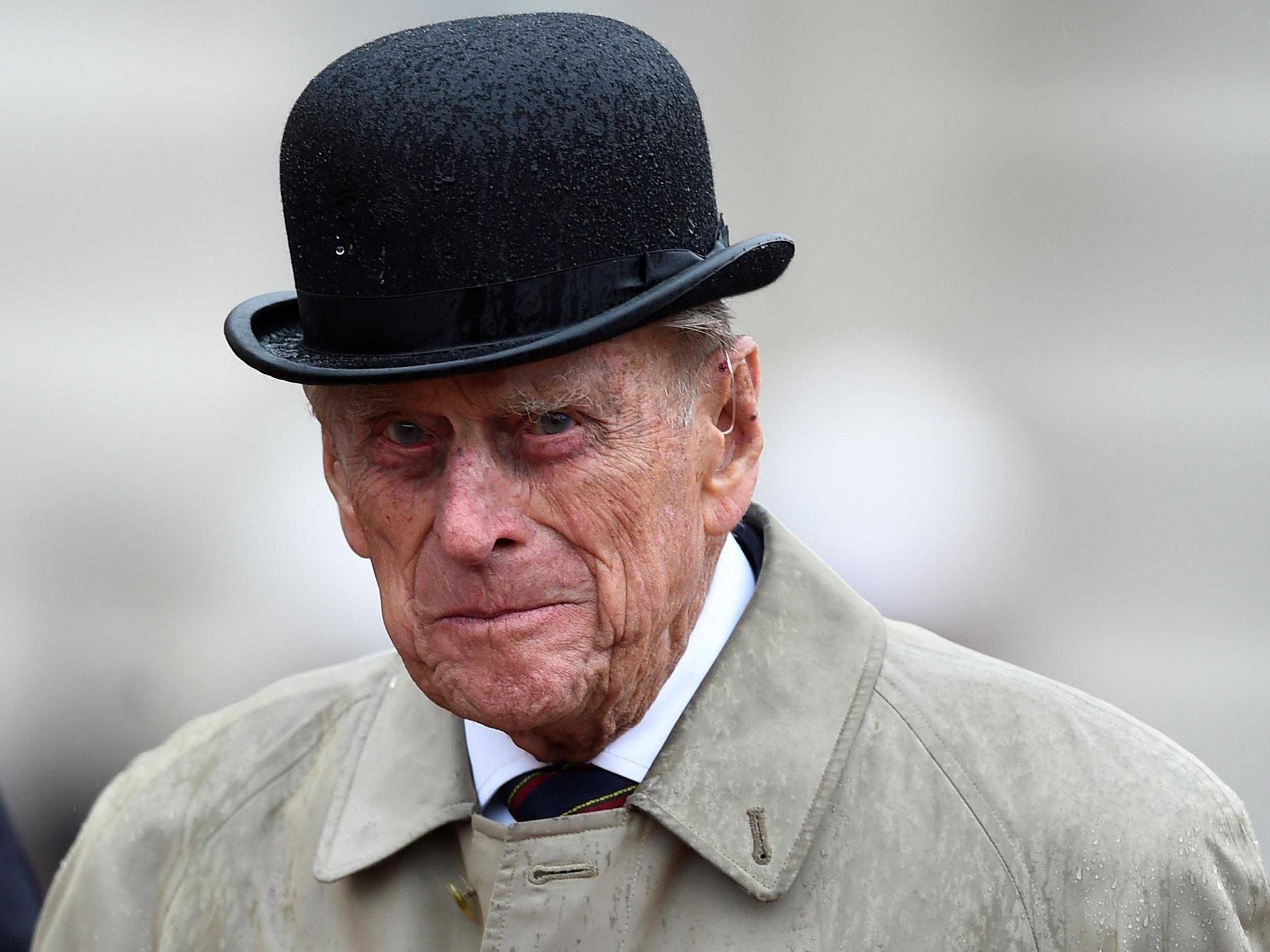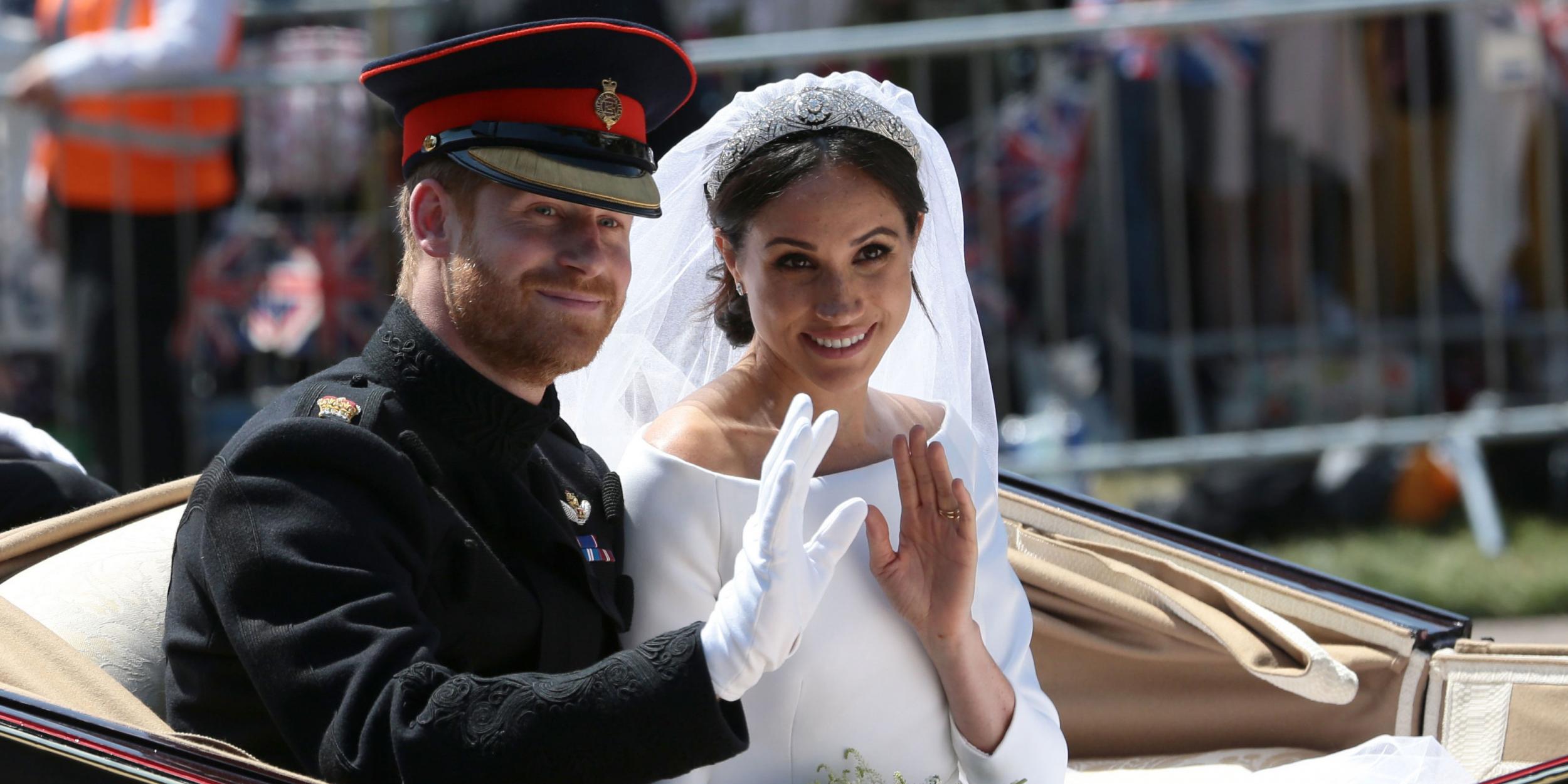Islanders who worship Duke of Edinburgh celebrate royal wedding by eating 'many, many pigs'
He's not the granddad of the groom, he's the son of god

Your support helps us to tell the story
From reproductive rights to climate change to Big Tech, The Independent is on the ground when the story is developing. Whether it's investigating the financials of Elon Musk's pro-Trump PAC or producing our latest documentary, 'The A Word', which shines a light on the American women fighting for reproductive rights, we know how important it is to parse out the facts from the messaging.
At such a critical moment in US history, we need reporters on the ground. Your donation allows us to keep sending journalists to speak to both sides of the story.
The Independent is trusted by Americans across the entire political spectrum. And unlike many other quality news outlets, we choose not to lock Americans out of our reporting and analysis with paywalls. We believe quality journalism should be available to everyone, paid for by those who can afford it.
Your support makes all the difference.It was like a royal wedding street party with a difference.
One difference being that there was no street, just a gaggle of huts on a South Pacific island.
The other being that those partying regarded the groom’s granddad the Duke of Edinburgh, not as a cantankerous, gaffe-prone senior royal, but as the son of god.
In the village of Yaohnanen, on the island of Tanna in the archipelago republic of Vanuatu, Prince Philip is worshipped as a sort of Messiah, the son of their ancestral mountain god.

Which meant that while there were some signs of indifference in Britain, 10,000 miles away in the South Pacific Prince Harry and Meghan Markle’s wedding was celebrated with dancing, Union Flags and feasting on “many, many pigs”.
That is, once the message had got through to the villagers – who tend not to bother with modern electronic communications systems – that the wedding was happening.
“We had a custom dance and we put the flag up," Jack Malia, the village chief, told a reporter from The Times. "We had a celebration for the prince. There were many, many pigs. We had many, many people come who wanted to celebrate.”
With the atmosphere further lifted by kava, a drink made from a plant root said to have sedative and mood-enhancing qualities, the celebration seems to have been even more joyous than those for the duke’s 89th birthday on June 10 2010.
That was when it had been prophesied that Prince Philip would come to Tanna to be with his people, living in a hut and hunting wild pigs with them.
The slight disappointment that the duke/Messiah was a no-show on that occasion was mitigated by the fact that British gap year student Marc Rayner, 18, was on hand to act as a stand-in.
As a stickler for protocol, the duke would doubtless have been glad to hear that Mr Rayner adopted formal dress by wearing a nambas, a slightly more extensive version of the penis sheaths that Tanna men wear in everyday life.
“They are a wonderful people and I didn’t want them to feel let down,” said Mr Rayner. “I stepped in to explain that the prince's many responsibilities prevented him from visiting in person - but that he would one day rest in spirit on the island.”
As it is, however, although Tanna is the home of the so-called “cargo cult” known as the Prince Philip Movement, the duke – in bodily, if not spirit form – has never set foot on the island, one of 82 in the Vanuatu archipelago.
The closest he came was in 1974, when he visited the Vanuatu capital Port Vila on the royal yacht Britannia with the Queen.
Chief Jack Naiva, one of the paddlers of a traditional war canoe which greeted the royal yacht, was quoted as saying: "I saw him standing on the deck in his white uniform. I knew then that he was the true messiah."
Tanna elders later sent Prince Philip a "nal nal" hunting club. He sent them back a picture of himself holding the club. The photo has become a cherished religious icon on Tanna.
In the village of Yaohnanen there is a sort of shrine to the duke, with a Union Flag draped over framed photographs of the Queen’s consort.
Last year’s announcement that he would be retiring from public life did nothing to dampen the people of Tanna’s devotion to him.
Jimmy Joseph Nakou told reporters from the Associated Press that it was still the custom for villagers in Yaohnanen and Yakel to gather every evening, drink kava, and pray to Prince Philip.
“We ask him to increase the production of our crops in the garden, or to give us the sun, or rain,” he said. “And it happens.
“Here in Tanna, we believe that Prince Philip is the son of our god, our ancestral god, who lives up in the mountain."
As The Independent reported at the time, even the fact that Prince Philip’s May 2017 retirement announcement coincided with the impending arrival of a cyclone did nothing to put them off the duke, whose remarks have been known to offend others.
Author and journalist Matthew Baylis suggested the cyclone might instead have been taken as a sign that the duke had attained a higher “sacred status”.
Mr Baylis, who has spent time living on Tanna, explained: “They told me that they see Philip’s living in a palace, surrounded by guards, and travelling in a car with darkened windows, as evidence of his taboo status.
“So they may well see his withdrawal from public duties as connected to that – having attained some higher rung of taboo, sacred status.”
And while Prince Philip has never come to the people of Tanna, the people of Tanna have come to him.
In 2007 the makers of the Channel 4 documentary Meet the Natives arranged for a delegation of five islanders – of whom Jimmy Jospeh was one – to meet Prince Philip in Windsor Castle, the location of last weekend’s wedding.
Before the meeting, there was some trepidation in anthropological circles, with The Independent reporting: “In one slip of his tongue, he would after all be capable of shaking their entire religion to its foundations – and the Duke is not, let's face it, a man renowned for tact.”
As it happened, however, the meeting passed off without any damage to the Prince Philip Movement, with Mr Joseph saying later: “Because we believe that he is the son of our god, meeting him is just wonderful."
The Independent also watched as, ahead of their visit to Windsor, the men from Tanna grew wildly excited at the sight of another of the duke’s homes: Buckingham Palace, “the big house”.
At Madame Taussauds, the men ignored all the Hollywood stars and spent an hour admiring Prince Philip’s statue, hugging it and holding its hand.
The documentary, however, also showed how at times the men of Tanna viewed the natives of Britain as both comical and uncivilised.
They were reduced to fits of giggles by the sight of a woman taking her pet to a dog grooming salon.
“This is one of the strangest sights we have seen,” said one member of the Tanna delegation. “Two women bathing dogs and giving them haircuts as if they were human.”
The men, however, were appalled and bewildered by the sight of homeless rough sleepers.
“We don't really see how it is possible that a city with so much money and so many buildings can have people sleeping on the streets,” said one of the men. "Why is it there are many buildings not used and people are still homeless?
“On Tanna no one is homeless. Everybody is equal in wealth. If you need a house, everyone will help you build one."
On a more positive note, their familiarity with ritual dancing on Tanna meant they were unfazed by a nightclub in Britain, and when they were taken to a typical pub, they proved to be brilliant at darts.
Although the idea of worshipping Prince Philip might seem bizarre to his British subjects, some anthropologists have described cargo cults generally as fairly logical attempts to make sense of a world challenged first by the arrival of white colonialists and then by the chaos of global war.
In a 1959 Scientific American article, the British social anthropologist Peter Worsley wrote: “Observers have not hesitated to use such words as ‘madness,’ ‘mania,’ and ‘irrationality’ to characterize the cults. But the cults reflect quite logical and rational attempts to make sense out of a social order that appears senseless and chaotic.”
He outlined how South Pacific populations with “highly developed cultures” had been subjected to “enormous social stress and strain” by the arrival of Europeans with “cargo” – Pidgin English for trade goods – and frightening technological power.
With the 19th Century traders came missionaries, who thought it would be clever to try to make Christian ideas like the Second Coming more palatable by tacking them on to existing South Pacific beliefs.
The result, however, seems to have been that instead of Christinaity, beliefs grew up that a local hero or god would come to initiate paradise on Earth and bless the people of the South Pacific with the riches of the white man’s cargo.
Worsley explained that the seizure of islanders for work on the plantations of Australia and Fiji left them disinclined to swallow whole the missionaries’s teachings: “The splendid vision of the equality of all Christians began to seem a pious deception in face of the realities of the colour bar, the multiplicity of rival Christian missions and the open irreligion of many Whites.
“They found that acceptance of Christianity did not bring the cargo any nearer. They grew disillusioned.”
Then the Second World War came to the Pacific.
“Troops on both sides,” wrote Worsley, “Found their arrival [was] heralded as a sign of the Apocalypse. The G.I.s who landed in the New Hebrides [later renamed Vanuatu], moving up for the bloody fighting on Guadalcanal, found the natives furiously at work preparing airfields, roads and docks for the magic ships and planes that they believed were coming from "Rusefel" (Roosevelt), the friendly king of America.”
On some Pacific islands, Worsley added: “Mock wireless antennae of bamboo and rope had been erected to receive in advance the news of the [Second Coming].”
On Vanuatu the appearance of so many troops and so much US military hardware seems to have boosted the “John Frum Movement” that had begun in the 1930s, and was still going strong in 1960 when David Attenborough visited to be told about a Messiah figure: “’E look like you. ‘E got white face. ‘E tall man. ‘E live ‘long South America.”
On Tanna, the John Frum Movement seems to have morphed into the Prince Philip Movement some time in the 1950s or 1960s.
One theory is that people on Tanna noticed the respect with which British colonial officials spoke of the Queen, and aligned Prince Philip with their traditional belief that the son of the mountain god would travel over the sea, marry a powerful woman and eventually return to his people.

And at the time the duke's retirement, it was also suggested that the Prince Philip Movement would not die with him.
Tanna elder Chief Tom Numake was quoted as saying: “Just because he has retired, it doesn't just stop.
“It will be passed on to his children, and if they have children then it will continue on through them. The followers don't just see it as Prince Philip but that it will continue going on through the bloodline."
Which does now rather suggest that in the unlikely form of Prince Harry, Meghan Markle has just got herself hitched to a husband who might one day, just possibly, come to be seen, as the Messiah, not a very naughty boy.
Join our commenting forum
Join thought-provoking conversations, follow other Independent readers and see their replies
Comments